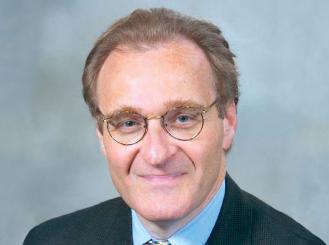Feb 24, 2015
Introduction
Leo I. Gordon, MD
Robert H. Lurie Comprehensive Cancer Center of Northwestern University
There have been significant advances in our understanding of the biology of the B-cell malignancies over the past several years. These advances have enhanced our treatment options and have resulted in improved outcomes for patients with chronic lymphocytic leukemia (CLL) and other B-cell malignancies. In addition, important basic research has given us a better understanding of the B-cell receptor in normal and malignant B cells.
For the last 10 years, attempts to target components of this receptor have been under investigation; in the last several years, this research has led to novel treatments. For example, in the past two years, many of the clinical trials involving inhibitors of components of the B-cell receptor have been completed, results have been reported, and, with relatively quick turn-around, new drugs have gained U.S. Food and Drug Administration (FDA) approval.
Recent data have shown that ibrutinib, an inhibitor of BTK, has striking activity in CLL and mantle cell lymphoma when given as second-, third-, or fourth-linetreatment. This drug is now approved by the FDA as a second-line treatment in both disorders. Similarly, idelalisib,a PI3K-δ inhibitor, has been approved in CLL and follicular lymphoma as second-line treatment based on early clinical trial results.
This has led to the obvious question of whether these novel agents can now be used as part of initial treatment and how—or if—they might be incorporated into existing standard regimens. Does ibrutinib replace fludarabine/cyclophosphamide/rituximab (FCR) as a standard initial regimen in CLL? How long should patients be on this drug? Should it be added to FCR, and do we know enough to answer this question?
In this issue of ASCO Connection, Dr.Jeff Sharman begins to address thes eimportant issues and starts what promises to be an ongoing discussion.
Dr. Gordon is a hematologist/oncologist, theAbby and John Friend Professor of Cancer Research, and a Professor in Medicine-Hematology/Oncology at the Robert H.Lurie Comprehensive Cancer Center of Northwestern University. An ASCO member since 1979, he previously served as an Editor on the Journal of Clinical Oncology Editorial Board and as a Cancer EducationTrack Leader of the Scientific Program Committee.
Does Traditional FCR Chemotherapy Still Have a Place in Treatment of CLL?
By Jeff Sharman, MD
Medical Director of Hematology Research–US Oncology
2014 will likely be recognized as the year when management of chronic CLL entered the “modern era.” The introduction of abundant new treatment options, such as ibrutinib, idelalisib,and obinutuzumab, has resulted in dramaticimprovements in patient survival with agents that are well tolerated relative to their cytotoxic counterparts.Multiple second-generation drugs are being developed to improve upon the safety and efficacy of the approved novel agents, and therapeutics exploiting other key cellular proteins, such asBCL-2, will soon be available.
Given the substantial efficacy of these novel agents and their comparative ease of administration, it is likely they will be widely utilized in the coming years. However, there are several reasons why traditional chemoimmunotherapywith FCR should still be valued and considered for ongoing use as an effective therapy.
First, none of the novel agents appear to be curative. Both ibrutinib and idelalisib are designed as continuous therapiesthat control CLL; while responses appear to improve with time, neither drug appears likely to threaten the accepted wisdom that CLL is an incurable disease.1,2
Second, 15 years after the introduction of FCR into clinical practice, it is only now that some of the most compelling data supporting the use of this regimen have become available.
Compelling FCR-related data
A long-term follow-up of patients treated on the original FCR clinical trial at MD Anderson indicated that a sizable fraction of these patients remains free from progression in excess of 10years.3 Remarkably, a substantial numberof such patients test negative for minimal residual disease. The shape of the Kaplan-Meier curve demonstrates a plateau prompting some to question whether a subset of patients can be cured with FCR. While single center data have unique limitations, a similar phenomenon has been seen in long-term follow-up patients in the multicenter German CLL8 study, which compared FC to FCR.4
If a subset of patients can be cured of their CLL with a short course of intensive chemoimmunotherapy, one might expect strong interest in the regimenby both patients and physicians alike.Unfortunately, patterns of care derived from data sets indicate limited enthusiasm for FCR within the community.5 If novel agents further dilute interest in aggressive therapy, some curable patients may never be given the chance to live disease-free. The challenge to the CLL research community, therefore, is to prospectively identify curable patients who are suitable to receive intensive chemoimmunotherapeutic regimens, such as FCR.
Identifying patients who will benefit from FCR
Unfortunately, diagnostic tools for prospective identification of patients who might be considered “curable” have not been widely available. While minimal residual disease is a powerful predictor of long-term outcome, this can only be established after treatment has been completed. Challenges such as these underscore the idea that while clinicians might wish to see their patients do very well in long-term follow-up, new methods are neededto determine which patients are likely to have such a long-term benefit from FCR before initiating therapy; this information will help limit toxicity to those patients who will likely benefit from treatment.
The traditional markers used to predict who will benefit from FCR have relied heavily upon fluorescence in situ hybridization (FISH) testing in order to segregate patients with CLL into several key risk groups. Patients whose CLL contains deletion of chromosome17P or 11Q do poorly with chemoimmunotherap yand are unlikely to be cured by FCR. Unfortunately, many patients lacking these high-risk markers also do poorly; FISH testing alone inadequately predicts outcome.
TP53 gene mutations have similar negative predictive value for 17P deletions; however, these mutations occur at the sequence level rather than at the level of large genomic deletions and are undetectable by FISH.6 Next generation sequencing technology has recently identified a variety of mutations, including BIRC3, SF3B1, andNOTCH1, that also negatively predict outcome.7 When these mutations are evaluated in combination with FISH, a far more accurate picture of prognosis emerges. A novel risk stratification schema based on these mutations has been proposed, and, fortunately, risk based on this schema can be established prior to initiating therapy and has the power to predict outcome.
When the TP53, BIRC3, SF3B1, and NOTCH1 markers are applied to the CLL8 study (FC versus FCR), they complement FISH testing and segregate outcome more robustly than prior risk stratification strategies. Analysis shows that patients lacking any high-risk markers—as determined by both FISH and sequencing—do remarkably well.
Approximately one-quarter of patients enrolled on the CLL8 study had such favorable molecular markers. Patients with favorable markers who were treated with FCR had a seven-year progression-free survival of nearly 70%, indicating that if any patients with CLL are actually cured by FCR, it is likely to be those who lack the high-risk markersas determined by both FISH and the sequencing of adverse mutations in key genes.4 Considering that this analysis was done without the benefit of next generation sequencing (which is moresensitive), it is likely that a subgroup of this population could experience even better clinical outcomes. Such testing is now commercially available.
Identifying patients who are “fit”enough for FCR
The second challenge to the CLL research community is to identify which patients are “fit” enough for treatment with FCR. Not all potentially “curable” patients are sufficiently fit to receive FCR, even if they lack the high-risk markers. The median ages of patients treated on the MD Anderson trial and the German CLL8 study were 57 and 61, respectively. On average, patients treated within the community setting are 10 years older than those seen in academic medical centers, and the median age at diagnosis of CLL is 71. This increased age is associated with greater medical comorbidity, lower performance status, and lower renal function.8 As a result, older individuals do not tolerate FCR as well as younger individuals. If entry criteria for CLL8 are applied to patients treated in community practice, only 20% of patients would meet entry criteria for that study.
A goal of individualized care
In conclusion, while novel therapeuticsare transforming the management of CLL, the efficacy of the FCR regimen should not be disregarded. Instead, it should be selectively applied to those patients most likely to receive greatest benefit from the regimen, particularly if longer-term follow-up from landmark studies continues to suggest that some patients are curable.
To achieve the goal of determining which patients benefit from FCR, the research community needs to strenuously validate novel molecular markers across ongoing clinical trials. When selecting first-line therapy for patients with CLL, it is important to consider the goals of therapy. If a fit younger patient has a favorable risk profile, intense chemoimmunotherapy may be the best route for long-term disease control—and possibly cure. Conversely, genomic risk markers identify many patients for whom the side effects of intensive chemoimmunotherapy may outweigh the benefit. For these patients, novel agents may provide the best long-term outcome.
Where the line is drawn between the two extremes is likely to depend upon both the individual patient and the individual disease biology. Fortunately, at this moment in time, these pieces are all coming together.
Dr. Sharman is a hematologic oncologistat the Willamette Valley Cancer Institute in Eugene, Oregon, and is the Medical Directorof Hematology Research for the US Oncology Research Network. He has been an ASCO member since 2005. To read his blog,visit cll-nhl.com.
References
1. Byrd JC, Brown JR, O’Brien S, et al. N Engl J Med. 2014;371:213-23.
2. Furman RR, Sharman JP, Coutre SE, et al.N Engl J Med. 2014;370:997-1007.
3. Keating MJ, Tam CS, Wierda WG, et al. ASH Annual Meeting Abstracts, 2012 (abstr3929).
4. Stilgenbauer S, Schnaiter A, Paschka P, et al. Blood. 2014;123:3247-54
5. Sharman J, Flowers CR, Weiss M, et al. ASH Annual Meeting Abstracts, 2011 (abstr2864).
6. Rossi D, Khiabanian H, Spina V, et al. Blood.2014;123:2139-47.
7. Chiaretti S, Marinelli M, Del Giudice I, et al. Leuk Lymphoma. 2014;55:2785-92.
8. Sharman JP, Mato A, Kay NE, et al. ASH Annual Meeting Abstracts, 2014 (abstr3338).



